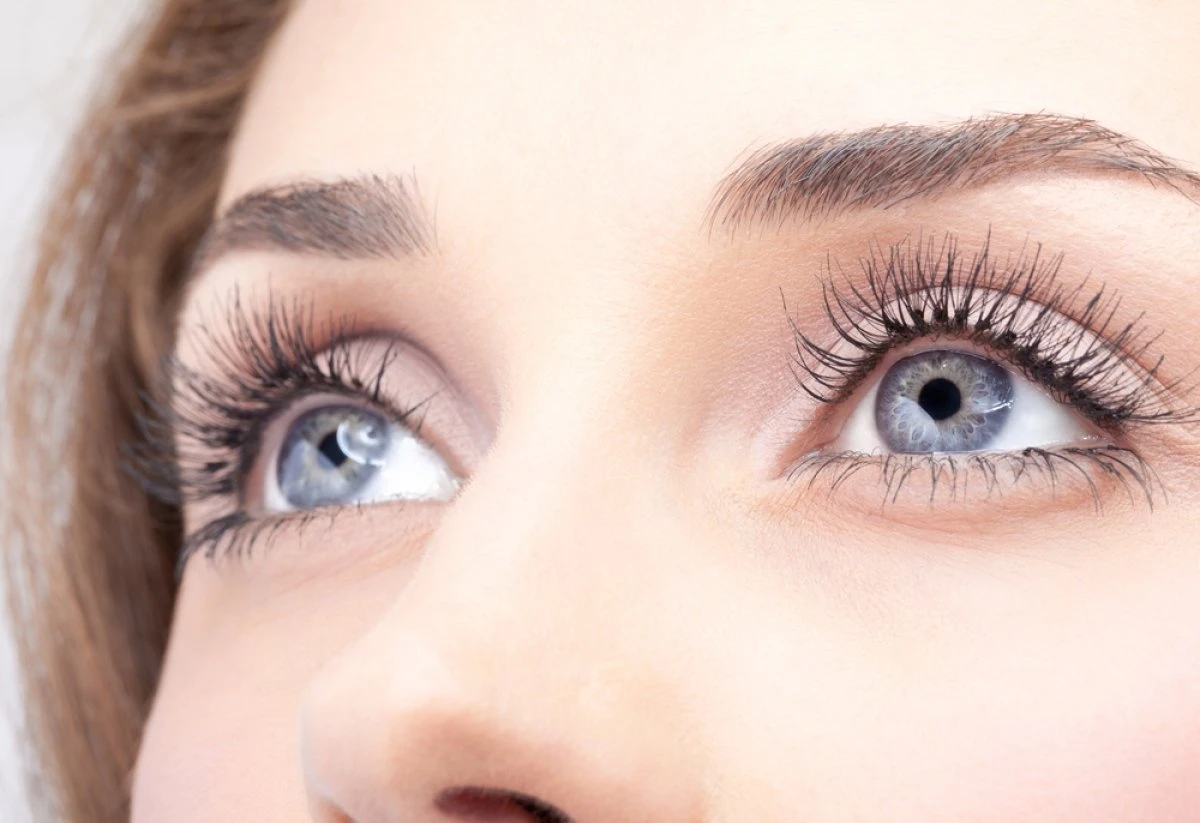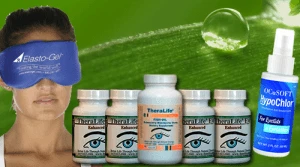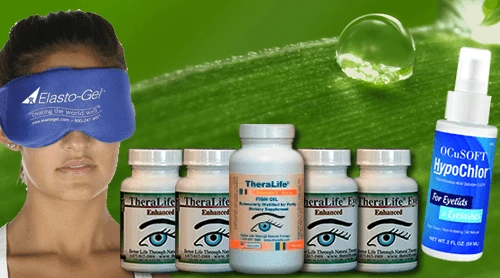To naturally relieve blepharitis, consider using products from TheraLife. They offer comprehensive solutions designed to support eyelid hygiene and overall eye health. Their products, such as those rich in omega-3s, can help reduce ocular inflammation, which is a common issue in blepharitis. TheraLife’s offerings are formulated to gently cleanse the eyelids without harsh chemicals, making them suitable for sensitive eyes. They also provide dietary recommendations and supplements that aid in reducing the recurrence of flare-ups. By integrating TheraLife’s solutions into your routine, you can maintain healthy eyelids and minimize discomfort.
Best Blepharitis Treatment From TheraLife- When Drops Don’t Work.
Key Takeaways
- Apply a warm, damp compress to closed eyelids for 5–10 minutes daily to loosen debris and unclog meibomian glands.
- Gently cleanse eyelid margins with a hypoallergenic, fragrance-free cleanser or diluted baby shampoo to remove crusts and reduce bacteria.
- Avoid products with alcohol, artificial fragrances, or essential oils to prevent irritation and protect delicate eyelid skin.
- Incorporate anti-inflammatory foods like fatty fish, flaxseed, and leafy greens to help reduce ocular surface inflammation.
- Maintain daily eyelid hygiene and avoid eye makeup during flare-ups to minimize recurrence and support natural healing.
Understanding Blepharitis and Its Symptoms
Blepharitis, a common inflammatory condition affecting the eyelid margins, often presents as redness, swelling, irritation, and crusting near the eyelashes.
You may notice symptoms such as a gritty or burning sensation, excessive tearing, and eyelids that feel sticky, particularly upon waking. Accurate symptom identification is vital for timely and effective management.
Blepharitis causes include bacterial colonization, dysfunction of the meibomian glands, seborrheic dermatitis, and allergic reactions. Recognizing these causes helps you differentiate blepharitis from other ocular surface diseases and develop an appropriate care plan.
If you consistently experience eyelid discomfort, persistent eyelash debris, or recurrent conjunctivitis, you’re likely dealing with blepharitis. Using eyelid hygiene as a routine management strategy can significantly alleviate symptoms and prevent complications.
Warm Compress Techniques for Soothing Relief
Managing eyelid inflammation and discomfort requires targeted strategies that address the underlying causes identified earlier.
Utilizing warm compress techniques delivers proven warm compress benefits for individuals with blepharitis. Applying a clean, damp cloth warmed with water between 40°C and 45°C directly over your closed eyelids for 5–10 minutes helps to liquefy and mobilize thickened meibum, thereby improving meibomian gland function. Heated eye masks provide non-invasive options that deliver precise heat to soften chalazion contents, facilitating natural drainage.
This method also facilitates debris and crust removal, relieves eyelid margin irritation, and enhances tear film stability. Repeating these soothing techniques twice daily guarantees consistent symptomatic relief and promotes ideal eyelid hygiene.
Always use a fresh cloth to minimize contamination and apply gentle pressure without excessive force to avoid further irritation. Integrating these warm compresses into your daily routine effectively supports overall blepharitis management.
Gentle Cleansing Routines for Eyelid Care
To optimize eyelid hygiene, you’ll need to choose non-irritating cleansing products and use precise techniques.
Gentle eyelid massage aids in debris removal, but avoid any substances that could exacerbate inflammation.
Evidence supports that consistent use of safe cleansers and proper technique reduces blepharitis symptoms effectively.
It’s important to address clogged meibomian glands as part of your routine, as they are a common cause of blepharitis and dry eyes.
Selecting Safe Cleansing Products
Although eyelid hygiene is crucial for controlling blepharitis symptoms, selecting safe cleansing products is essential to avoid irritation or worsening of inflammation. Always review product labels to verify safe product ingredients, such as preservative-free, fragrance-free, and hypoallergenic formulations. Avoid soaps with harsh detergents or alcohol, as these may disrupt the delicate balance of your eyelid margins. Effective cleansing methods utilize gentle, non-abrasive cleansers designed for sensitive ocular surfaces. If uncertain, consult an ophthalmologist before introducing a new product. Warm compress therapy has been shown to increase tear film stability and reduce inflammation, making it a crucial part of a comprehensive treatment plan. The following table highlights the emotional impact of product selection:
| Concern | Unsafe Choice | Safe Alternative |
|---|---|---|
| Burning sensation | Alcohol-based cleanser | Hypoallergenic wipes |
| Itching | Fragranced soap | Preservative-free foam |
| Redness | Harsh detergent solution | Non-ionic surfactants |
| Anxiety | Unverified online brands | Clinically-tested wash |
Best Blepharitis Treatment From TheraLife- When Drops Don’t Work.
Proper Eyelid Massage Technique
Eyelid massage plays an essential role in blepharitis management by promoting effective gland expression and removal of debris along the lash margins.
To begin, cleanse your hands thoroughly, then gently close your eyes. Using a clean fingertip or a cotton swab, apply light eyelid pressure to the upper and lower lids, moving in a circular or linear motion toward the lash line. This technique helps mobilize meibomian gland secretions and reduces inflammation.
Maintain a gentle, consistent pressure—never press too hard, as excessive force can cause irritation. Evidence suggests ideal massage frequency is once or twice daily, depending on symptom severity and your ophthalmologist’s guidance.
Adhering to proper massage technique supports eyelid health and can improve blepharitis outcomes when combined with regular cleansing routines. Incorporating warm compress application into your routine can further enhance the effects of eyelid massage by loosening clogged oils and improving tear quality.
Avoiding Harsh Irritants
Since the delicate skin of your eyelids is particularly susceptible to irritation, it’s essential to choose gentle cleansing products free from fragrances, alcohol, and harsh chemicals. Ingredients like artificial scents, essential oils, and preservatives often function as allergy triggers, exacerbating blepharitis symptoms. Instead, opt for non-foaming, hypoallergenic cleansers or saline solutions specifically intended for ocular use. Avoid traditional facial wipes and make-up removers, which may contain surfactants or irritants. Contaminated eye makeup can lead to blepharitis and conjunctivitis, with symptoms worsening with continued use.
| Common Irritants | Possible Effects | Recommended Alternatives |
|---|---|---|
| Fragrances | Allergic reactions | Fragrance-free cleansers |
| Alcohol | Dryness, irritation | Saline solution |
| Essential oils | Contact dermatitis | Hypoallergenic eyelid wipes |
| Preservatives | Chronic inflammation | Preservative-free products |
| Surfactants | Ocular surface damage | Non-foaming cleansers |
Consistent avoidance supports effective eyelid hygiene and symptom management.
Natural Ingredients to Support Eye Health
Several natural ingredients, such as omega-3 fatty acids, green tea extract, and aloe vera, may offer adjunctive support for overall eye health. Research suggests that omega-3 fatty acids can contribute to the stabilization of the tear film, potentially easing ocular surface irritation associated with blepharitis. You might also consider herbal infusions, for example, cooled chamomile or calendula tea compresses, which have mild anti-inflammatory and soothing properties. Green tea extract contains polyphenols with antioxidant benefits that support periocular tissue integrity. Aloe vera gel, when used with caution and free from additives, may provide mild symptom relief due to its anti-inflammatory effects. Using essential oils, such as diluted tea tree oil, requires caution to avoid ocular irritation; clinical evidence supports their use for lid hygiene in demodex blepharitis. Additionally, patients with rheumatoid arthritis, which can lead to ocular inflammatory conditions like scleritis and episcleritis, may benefit from regular eye health exams to monitor and manage potential complications.
Dietary Changes That May Help Reduce Inflammation
You can support eyelid health by emphasizing anti-inflammatory foods such as leafy greens and fatty fish in your diet. Evidence suggests that omega-3 fatty acids help reduce ocular surface inflammation associated with blepharitis. Additionally, limit intake of sugar and processed foods, as these may exacerbate inflammatory processes. Including omega-3 fish oil supplements in your diet may also aid in improving oil film production by meibomian glands, which can alleviate symptoms of dry eyes.
Best Blepharitis Treatment From TheraLife- When Drops Don’t Work.
Anti-Inflammatory Foods Selection
While addressing blepharitis, incorporating anti-inflammatory foods into your diet may help modulate the underlying inflammatory response associated with this condition.
You should consider including anti-inflammatory herbs such as turmeric and ginger, both of which contain bioactive compounds demonstrated to reduce pro-inflammatory mediators.
Antioxidant-rich fruits like blueberries, strawberries, and oranges supply essential vitamins C and E, as well as flavonoids, that scavenge free radicals and potentially limit oxidative stress on eyelid tissues.
Leafy greens, such as spinach and kale, also offer abundant phytochemicals and carotenoids with anti-inflammatory properties.
Evidence suggests that consistent intake of these foods supports immune regulation and may decrease the frequency or intensity of blepharitis flare-ups.
For optimal eyelid hygiene, consider using warm compresses to loosen crusts and promote better circulation to the eyelids.
Prioritize a varied, nutrient-dense diet to complement your topical eyelid hygiene regimen for ideal ocular surface health.
Omega-3 Fatty Acids
In addition to integrating anti-inflammatory foods, focusing on dietary sources of omega-3 fatty acids can further modulate the inflammatory processes associated with blepharitis. Omega-3 fatty acids, found in both marine and plant-based foods, exhibit anti-inflammatory properties that may reduce eyelid irritation and support ideal meibomian gland function. You can benefit from omega 3 sources such as fatty fish, flaxseeds, and walnuts, which are readily available in most diets. Consistent intake is associated with reduced ocular surface inflammation and improved tear stability—core omega 3 benefits for individuals managing blepharitis. Additionally, Omega-3 Fish Oil Benefits include assisting in preventing macular degeneration and cataracts, further supporting overall eye health.
| Omega 3 Source | Daily Portion | Key Benefit |
|---|---|---|
| Salmon | 85g (cooked) | EPA/DHA for anti-inflammation |
| Flaxseed | 1 tablespoon | ALA for lipid modulation |
| Walnuts | 30g (about 7 nuts) | Overall ocular surface support |
Sugar and Processed Reduction
Although convenient foods often dominate modern diets, frequent consumption of added sugars and processed products correlates strongly with systemic inflammation, which may exacerbate blepharitis symptoms.
Excess sugar intake disrupts immune regulation and may worsen inflammatory responses affecting the eyelids. Processed foods frequently contain trans fats, preservatives, and refined carbohydrates—compounds linked to heightened inflammation.
You should consider minimizing these dietary elements to favorably impact your blepharitis management. Opt for sugar alternatives, such as stevia or monk fruit, to satisfy sweet preferences without the inflammatory effects of refined sugar.
Select processed food alternatives like whole grains, fresh produce, and minimally processed proteins, which support systemic health and help modulate inflammation.
Adopting these evidence-based dietary changes complements other eyelid hygiene strategies, promoting sustained blepharitis relief.
Daily Habits to Prevent Recurrence
Establishing consistent daily eyelid hygiene routines plays an essential role in minimizing the risk of blepharitis recurrence. You should integrate evidence-based hygiene habits into your daily schedule to promote eyelid protection and prevent symptom flare-ups.
Effective routines remove debris, reduce microbial load, and maintain a healthy eyelid margin. It’s critical to avoid touching your eyes with unwashed hands and to protect your eyelids from irritants.
Adopt these three targeted actions:
- Clean eyelids daily: Use a sterile, preservative-free eyelid cleanser or diluted baby shampoo as recommended by an eye care specialist.
- Maintain hand hygiene: Wash your hands thoroughly before touching your face or eyes to prevent potential contamination.
- Avoid cosmetics during flare-ups: Forego eye makeup when symptoms appear to reduce further eyelid irritation.
Implementing these routines optimizes eyelid protection and minimizes recurrence.
Best Blepharitis Treatment From TheraLife- When Drops Don’t Work.
Frequently Asked Questions
Can Blepharitis Spread From Person to Person?
You may wonder about blepharitis transmission, but current evidence shows it typically doesn’t spread from person to person.
Blepharitis is usually due to bacteria naturally present on your skin or issues with the oil glands in your eyelids.
However, to support infection prevention, you should avoid sharing towels or personal items that touch your eyes.
Practicing good hygiene greatly reduces your risk of developing or worsening symptoms, even though direct person-to-person transmission is unlikely.
Is It Safe to Wear Eye Makeup With Blepharitis?
It’s no coincidence that you’re questioning your eye makeup routine while managing blepharitis.
Wearing makeup isn’t recommended during active flare-ups, as it can worsen inflammation and obstruct meibomian glands.
If you choose to use makeup alternatives, opt for hypoallergenic products and rigorously follow eye hygiene routines, removing all residue nightly.
Clinical studies emphasize that eye health improves when you avoid makeup until blepharitis is controlled, minimizing the risk of recurrence and potential complications.
How Long Does It Take for Symptoms to Improve?
When addressing blepharitis, you’ll notice that symptom duration varies.
With consistent, evidence-based treatment, most patients experience improvement within a few days to two weeks, although chronic cases may require ongoing maintenance.
Treatment effectiveness depends on compliance with recommended regimens such as eyelid hygiene and prescribed medications.
It’s important to continue therapy as directed, since premature discontinuation can prolong symptoms or cause recurrence.
Consult your ophthalmologist if symptoms persist beyond expected timelines.
Are Children Susceptible to Blepharitis, and Does Care Differ?
Yes, children can develop blepharitis, and you might notice child symptoms like redness, itching, and crusting at the eyelid margins.
When managing blepharitis in children, treatment differences exist primarily due to lower tolerance for certain products and the need for gentler techniques.
You’ll want to use mild, non-irritating cleansers and avoid harsh medications unless prescribed.
Routine eyelid hygiene and close supervision improve outcomes and guarantee proper pediatric blepharitis care.
Can Pets Contribute to Recurring Eyelid Inflammation?
Imagine tiny particles riding the backs of your furry companions, drifting onto your pillow each night.
Pets can indeed contribute to recurring eyelid inflammation if you have pet allergies or if their dander contaminates your environment.
Maintaining strict hygiene practices—such as regular pet grooming, frequent handwashing, and laundering bedding—can reduce allergen exposure.
Clinical studies increasingly link pet allergens to blepharitis recurrence, making environmental control critical to your ongoing symptom management.
Best Blepharitis Treatment From TheraLife- When Drops Don’t Work.
Conclusion
Theralife’s products offer effective solutions for individuals suffering from blepharitis and related eyelid conditions. By utilizing warm compresses and natural ingredients, these products help alleviate symptoms and promote long-term eyelid health. Theralife emphasizes the importance of anti-inflammatory dietary habits and consistent eyelid hygiene as strategies to prevent recurrence. Their offerings are designed to minimize discomfort and reduce the risk of complications, ensuring that customers can prioritize their eyelid health with confidence. Experience relief from blepharitis symptoms by integrating Theralife’s products into your daily routine.





